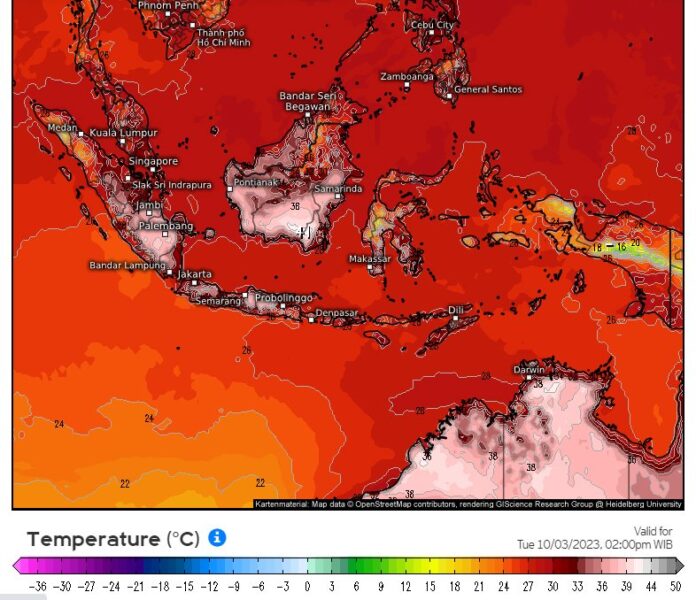Over the course of the past seven days, virtually the entirety of Indonesia has been engulfed in a striking episode of scorching daytime temperatures. Drawing upon data derived from the diligent observations of the Meteorology, Climatology, and Geophysics Agency (BMKG), we find that maximum temperatures in multiple regions of Indonesia have registered notably high readings, ranging between 35 and 38.0°C.
Remarkably, the most soaring maximum temperatures, spanning the period from September 22 to 29, 2023, have surged to an astonishing 38.0°C. These extraordinary readings were meticulously documented at the Climatology Station Office situated in Semarang, Central Java, specifically on the dates of September 25 and 29, 2023. Additionally, another noteworthy record was established at the Kertajati Meteorological Station, nestled within the picturesque region of Majalengka in West Java, on September 28, 2023.
In contrast, the maximum temperatures recorded within the Jabodetabek region, encompassing the Greater Jakarta area, have oscillated within the range of 35.0 to 37.5°C. Notably, the apex of this thermal spectrum, peaking at an impressive 37.5°C, was logged in South Tangerang on September 29, 2023.
This profound and encompassing rise in temperatures across virtually the entirety of Indonesia can be attributed to a multifaceted interplay of factors. As disclosed by the BMKG, the current phenomenon of scorching and intense heat is primarily induced by various atmospheric dynamics. Presently, weather conditions prevailing across the vast expanse of Indonesia, particularly in the regions of Java and Nusa Tenggara, which include the bustling Jabodetabek, are characterized by an overarching presence of clear skies and a conspicuous dearth of cloud formation, especially during the daylight hours.
This meteorological phenomenon effectively facilitates unhindered solar radiation, allowing sunlight to permeate the Earth’s surface with minimal interference from atmospheric clouds. Consequently, outdoor temperatures soar to exceptionally high levels during the daylight hours, manifesting as an intense heatwave.
It is common knowledge that a significant portion of Indonesia, particularly regions lying south of the equator, continues to grapple with the enduring dry season, while some areas are on the cusp of transitioning into the inter-monsoon period, typically spanning October to November. Consequently, the prevalence of clear weather conditions continues to dominate the diurnal landscape, contributing to the persistent heatwave.
Moreover, toward the conclusion of September, the apparent trajectory of the sun disclosed a gradual southward shift toward the equator. This celestial phenomenon translates into a heightened influence of solar radiation on select regions of Indonesia positioned south of the equator, encompassing the likes of Java and Nusa Tenggara. Notably, solar heating reaches optimal levels during the morning and approaches its zenith around midday.
However, it is crucial to underscore that this astronomical occurrence, in isolation, does not precipitate a dramatic or extreme escalation in surface air temperatures. Rather, the intensity of the heatwave is contingent upon a constellation of factors, prominently including wind speed, cloud cover, and atmospheric humidity levels. These elements wield a more substantial influence on the prevailing hot weather conditions currently experienced across multiple regions of Indonesia.
Anticipated forecasts suggest that the conditions characterizing this intense heatwave are poised to persist throughout the month of October. Consequently, the BMKG issues a prudent advisory to the populace, emphasizing the importance of preserving physical stamina and maintaining adequate hydration. This counsel is especially pertinent for individuals engaged in outdoor activities during the daytime, serving as a precautionary measure against the perils of dehydration, fatigue, and associated health ramifications.























